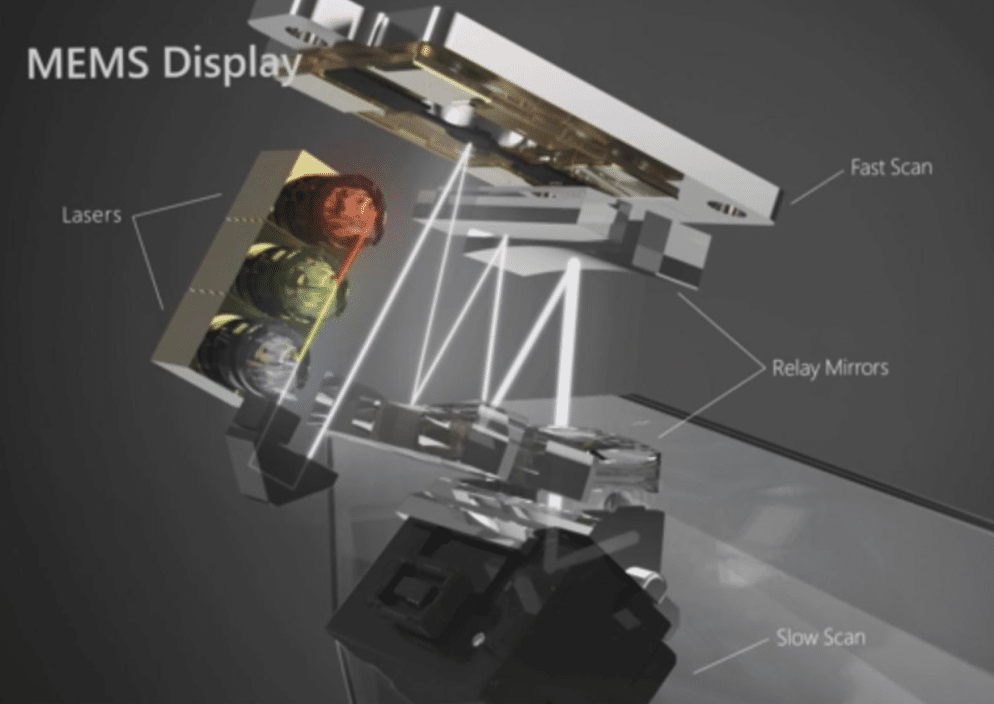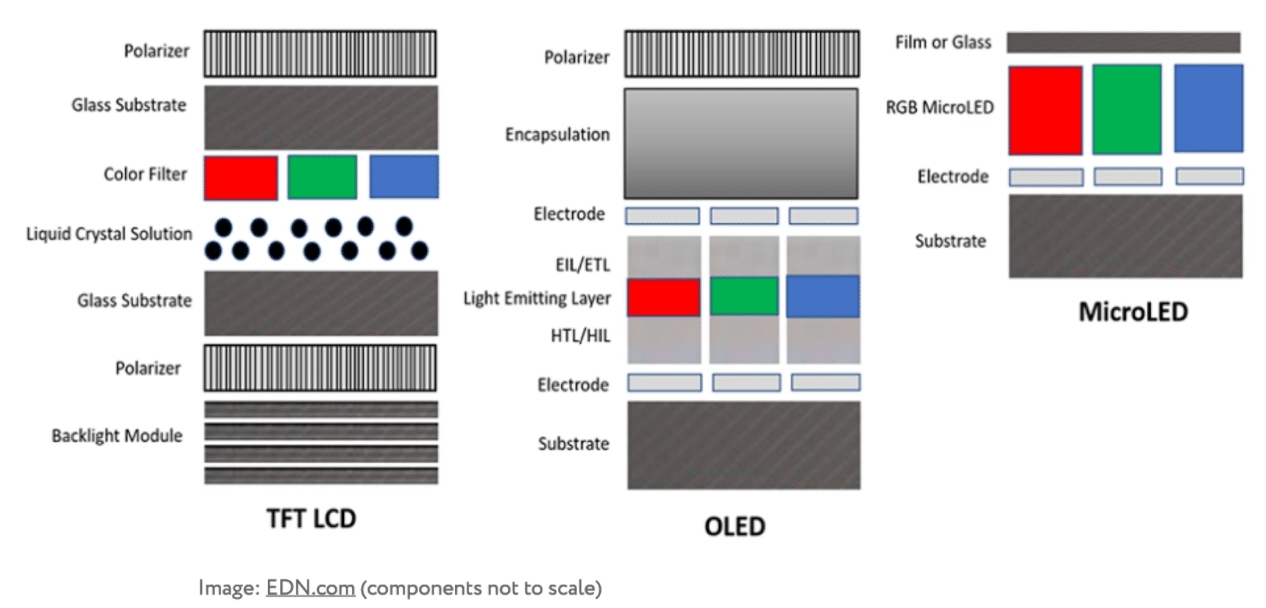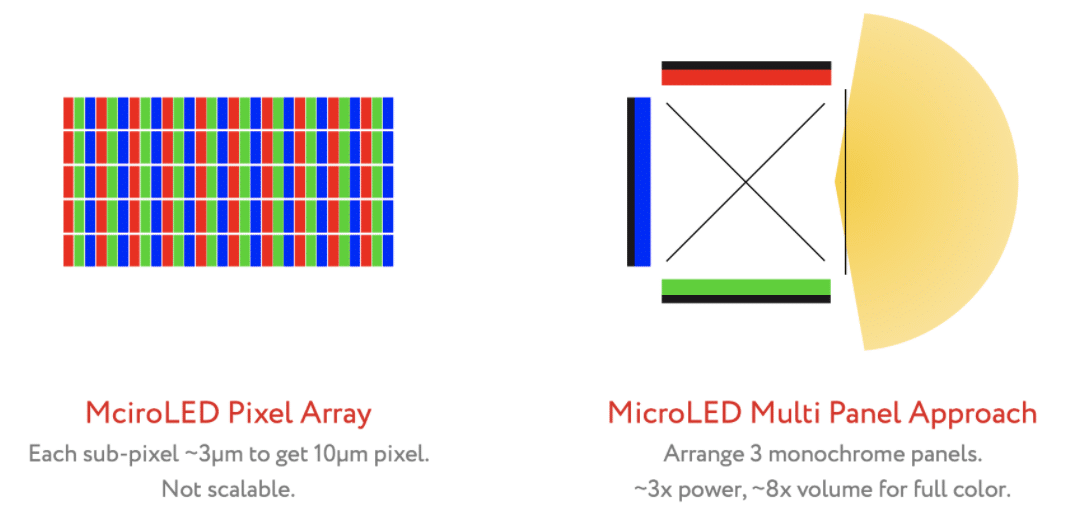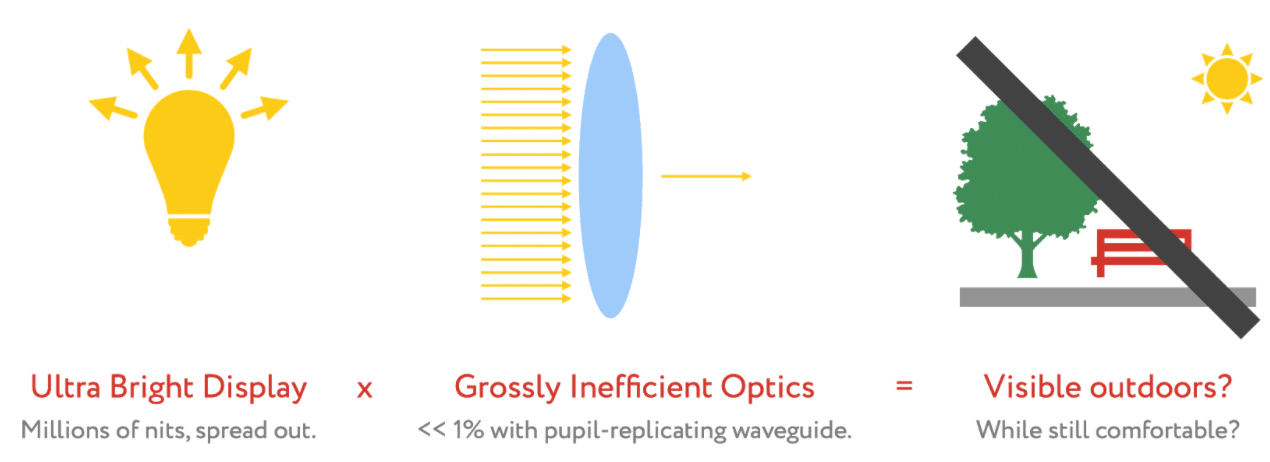
Charting a Path to Viable Consumer AR Glasses, Part III
The Hope for MicroLED and Laser Scanning Displays
by Jason McDowall
Welcome back to our series on the path to viable consumer AR. Over four parts, we’ll explore the biggest barriers and potential solutions to making consumer-grade Augmented Reality (AR) glasses that people will actually wear.
Part 1: The two biggest barriers holding wearable displays back are visual quality and device comfort, which hinge on the display and optics technology.
Part 2: The industry currently holds several assumptions about how displays and optics need to work, which impose very difficult implications on the overall design of AR glasses.
Part 3 (You are here): MicroLED and laser scanning displays hold promise and challenges.
Part 4: A different set of assumptions, with the right breakthrough innovation, may yield a better path.
Mass-Market Imperative
When building truly wearable, mass-market Augmented Reality (AR) glasses, it’s imperative we use the right combination of display and optics because they have an enormous impact on the  visual quality (both the quality of the digital image and the real world) and device comfort (both the physical and social comfort). However, the current consensus is to use (highly) inefficient and/or bulky optics paired with a dumb display that needs to be exceptionally bright. If we follow the consensus line of thinking, where can we find such an exceptionally bright display? (Remember, we are using the term “AR glasses” broadly to reference head-worn devices that allow you to directly see the real world as well as digital content, whether basic 2D content or more immersive 3D experiences tied to the real world.).
visual quality (both the quality of the digital image and the real world) and device comfort (both the physical and social comfort). However, the current consensus is to use (highly) inefficient and/or bulky optics paired with a dumb display that needs to be exceptionally bright. If we follow the consensus line of thinking, where can we find such an exceptionally bright display? (Remember, we are using the term “AR glasses” broadly to reference head-worn devices that allow you to directly see the real world as well as digital content, whether basic 2D content or more immersive 3D experiences tied to the real world.).
Organic LEDs and Lasers
When it comes to head-worn displays, microOLED (organic light-emitting diodes) can work great for VR because it’s fully enclosed. But even recent advancements from companies such as Kopin do not deliver nearly enough brightness for use in AR glasses with diffractive waveguides. Nreal’s use of MicroOLED shows that it can be viable with more efficient, but bulky curved mirror optics—as long as we stay indoors and don’t want to see each other’s eyes.
When it comes to head-worn displays, microOLED can work great for VR because it’s fully enclosed. But even the state of the art doesn't deliver enough brightness for use in AR glasses with diffractive waveguides. Share on XLasers can be exceptionally bright—bright enough to compensate for the inefficiencies of diffractive waveguides. But lasers don’t generate individual pixels on their own. To get full color across the entire viewable area requires the light from multiple lasers (at least 1 for each of red, green, and blue) to be constantly moved around in a scanning pattern, and the light intensity adjusted quickly. The scanning motion and rapid intensity adjustment can simulate pixels. Microsoft Hololens 2 attempts to use a laser scanner paired to a diffractive waveguide with disappointing results to the visual quality. North Focals used laser scanning with different optics, and they were planning a second version with an improved visual experience. We’ll see what Google does with the technology after the acquisition, although they reportedly dropped support for North’s first version and are not planning to ship the second version.

However, display and optics expert Karl Guttag predicts that laser scanning displays will never achieve the requisite visual quality within a wearable form factor. Some will disagree, but Guttag argues that while laser scanning looks very promising at first glance, like an iceberg, it is rife with big challenges once we go below the surface.
Lasers can be exceptionally bright—enough to compensate for the inefficiencies of diffractive waveguides. But lasers don’t generate individual pixels on their own. Share on XMicroLED Lights the Way?
MicroLED is an emerging technology for generating and modulating light. Similar to organic LEDs, inorganic LED-based displays are “emissive”, meaning they don’t need a separate light source, as required by DLP or LCD/LCoS displays. The benefit is they can be much more compact and more efficient. Another benefit is inorganic LEDs last much longer and can be driven much much brighter (1000s of times brighter) than OLED displays, and they’re even more power-efficient.

On the surface, microLEDs seem like a perfect solution for wearable displays. However, the technology isn’t mature yet. Outside of Ostendo (more on them later), no company has demonstrated a full-color microLED microdisplay suitable for wearable glasses (≤ 10 µm pixel pitch). It’s very difficult to make LED pixels smaller than 10 µm and arrange them in a grid pattern, which is compounded by the need to make each color component ~3 µm so the overall pixel can be 10 µm. Instead, to achieve full-color today, multiple single-color panels would need to be used and arranged to merge their light, requiring ~3 times the power and ~8 times the volume of a single full-color panel. This is a significant barrier when device comfort is paramount.

Companies are exploring ways to assemble single panels with full-color, but manufacturability is a key hurdle. The approach that has the most potential to scale to meet demand while achieving a reasonable cost is called “monolithic,” meaning the display chip is built up layer by layer using standard semiconductor tools and techniques. Plessey is a microLED display technology company pursuing this type of manufacturable, monolithic approach. Granted they still haven’t achieved full color yet, and it is a big jump from creating a one-color panel to a full-color panel. However, their approach is promising enough that Facebook effectively took them off the market. (Note: Plessey does have multi-color segmented displays, which means certain regions of the display can be pre-determined to be red or green or blue. It’s fine for swim goggles displaying lap times, but not for multipurpose glasses.).
On the surface, microLEDs seem like a perfect solution for wearable displays. However, the technology isn’t mature yet. Share on XEven MicroLED May Not Be Enough
However, even a full color microLED microdisplay, once available, will fall short of the ultimate goal (high visual quality and device comfort) when paired with complex and inefficient and/or bulky optics. The reason is multifold. First, the combiner optic is still either going to be bulky (curved mirror) or grossly inefficient (diffractive, pupil-replicating waveguide). In search of a better solution, some upstarts, such as Tooz, Oorym, and LetinAR, are pursuing alternative combiner optic designs, albeit with some other tradeoffs.
Second, the light coming from the display still spreads out, and it needs to be conditioned to get it into the lens. For diffractive waveguides, there’s an extra challenge of cramming all of the light from the relatively larger display into the smaller input coupling area. Even the high brightness from a MicroLED may not be enough to deliver sufficient brightness to make the device usable outdoors, much less a truly wearable, mass-market device.

Are we then stuck waiting 20+ years for the technology to evolve and meet our goals under these current assumptions?
Even the high brightness from a MicroLED may not be enough to deliver sufficient brightness to make the device usable outdoors, much less a truly wearable, mass-market device. Share on XNext Up
What if the assumptions are backward? What if we made the displays smarter and the optics less complex? What if we can accommodate a wider variety of human physiology and personal styles? What would that look like?
Old vs New Assumptions for Consumer-Grade Wearable Displays:

We’ll explore these questions in part 4.

Jason McDowall is VP of Visual Experience at Ostendo Technologies, and the creator and host of the AR Show podcast.






